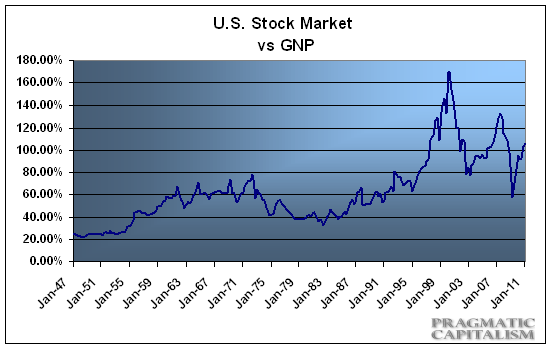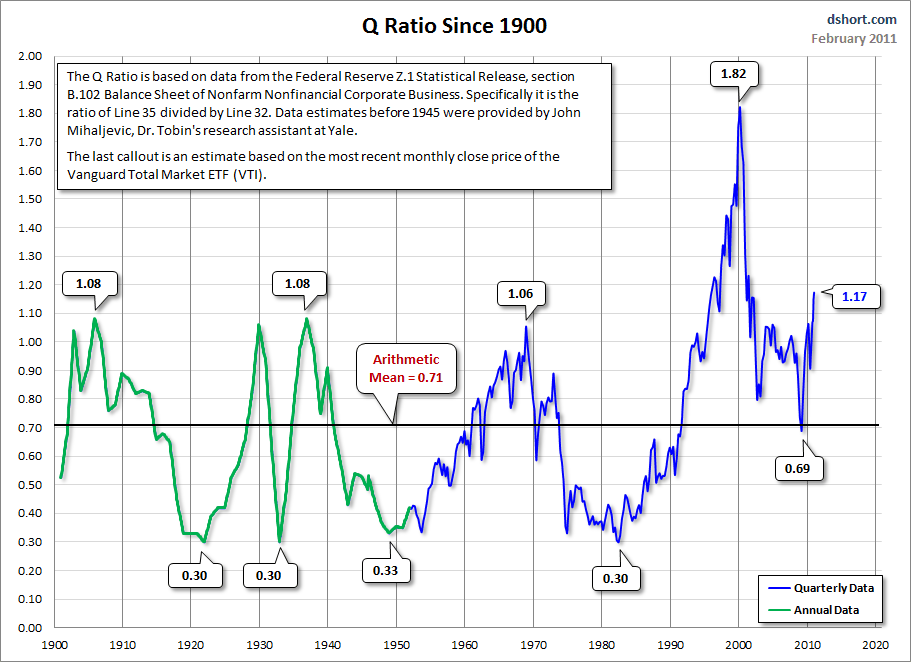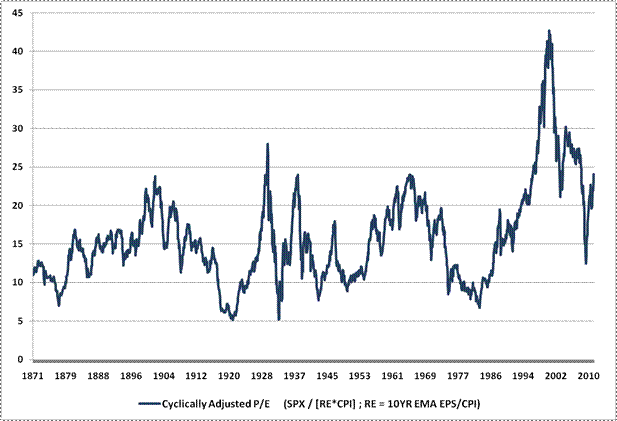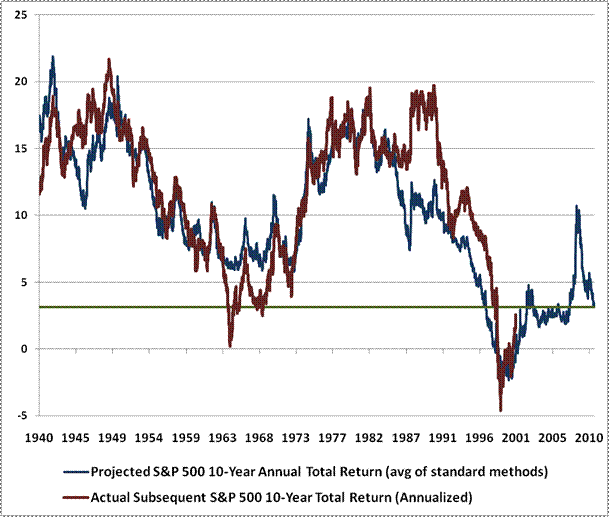As the market continues to grind higher each and ever day it’s useful to gain some perspective on just how much Bernanke is impacting valuations and generating disequilibrium in the market. In order to do so we’ll review a number of long-term valuation indicators.
The first is Warren Buffett’s self proclaimed favorite valuation tool (see here for more). He uses the total market cap of the US stock market compared to GNP. He has generally maintained that levels below 80% are bullish. The latest reading of 106% is well below the levels seen at the last two market peaks, but well above the historical average levels. You will notice that the permanently high valuations coincide with the Greenspan Put which has now morphed into the Bernanke Put.

John Hussman’s latest piece succinctly describes the current market environment in which Ben Bernanke continues to encourage speculation and malinvestment. As we all know by now it is Bernanke’s goal to keep asset prices “higher than they otherwise would be” in an attempt to generate a self sustaining economic recovery through asset prices. This is the insane notion that nominal wealth will lead to real wealth. In fact, Ben Bernanke has this quite backwards. Fundamentals drive real wealth – not nominal price increases. But two bubbles in one decade doesn’t teach this man a lesson. Hussman elaborates:
“Last week, the S&P 500 Index ascended to a Shiller P/E in excess of 24 (this “cyclically-adjusted P/E” or CAPE represents the ratio of the S&P 500 to 10-year average earnings, adjusted for inflation). Prior to the mid-1990′s market bubble, a multiple in excess of 24 for the CAPE was briefly seen only once, between August and early-October 1929. Of course, we observe richer multiples at the heights of the late-1990′s bubble, when investors got ahead of themselves in response to the introduction of transformative technologies such as the internet. After a market slide of more than 50%, investors again pushed the Shiller multiple beyond 24 during the housing bubble and cash-out financing free-for-all that ended in the recent mortgage collapse.
And here we are again. This is not to say that we can rule out yet higher valuations, but with no transformative technologies driving the economy, little expansion in capital investment, and ongoing retrenchment in consumer balance sheets, I can’t help but think that the “virtuous cycle” rhetoric of Ben Bernanke is an awfully thin gruel by comparison. We should not deserve to be called “investors” if we fail to recognize that valuations are richer today than at any point in history, save for the few months before the 1929 crash, and a bubble period that has been rewarded by zero total return for the S&P 500 since 2000. Indeed, the stock market has lagged the return on low-yielding Treasury bills since August 1998. I am not sure that even members of my own profession have learned anything from this.”
Using his expected returns methodology Mr. Hussman is looking for annual returns of just 3.15% in the coming decade:
Dshort brings us the Q Ratio which has now hit “nosebleed” territory again. This is consistent with the other metrics which all showed relatively stable ranges until the Fed began its unusual policy of propping up markets following the 87 crash. The latest reading of 1.17 is well below the Nasdaq bubble peak, but is higher than any other historical peak. “Nosebleed” could be an understatement.

As I mentioned in December, we have to ask ourselves if any of this matters as long as the Fed is directly involved in promoting speculation. It’s now clear that the Bernanke Put is well ingrained in every investor’s head. Never has the Federal Reserve been so explicit about propping up asset prices and it has created a speculative frenzy that has every investor trying to front-run the Fed. The problem for the Fed will be letting their foot off the gas. They have created a beast that they likely no longer control. When and if the Fed ever ends QE it is likely that markets will begin to revert to the mean. This will likely force the Fed’s hand to stabilize markets. So what we’ve created with this explicit backstop is a positive feedback loop. Can the Fed ever get out of the market now? And if they don’t it’s likely that markets will spiral higher until they cannot control the inevitable collapse.
The foolishness of current Fed policy cannot be downplayed. Let’s hope for the sake of US citizens that they are as quick to take credit for the inevitable market decline as they have been about taking credit for the rally. For once they admit to having contributed to malinvestment and misallocation of resources we can likely begin mounting a case that closes this horrible chapter in American history where the Central Bank attempted to turn our economy into a financialized ponzi scheme.


No comments:
Post a Comment